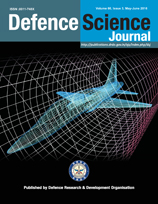Load Balanced Clustering Technique in MANET using Genetic Algorithms
DOI:
https://doi.org/10.14429/dsj.66.9205Keywords:
Clustering, genetic algorithm, load-balancing, mobile adhoc networksAbstract
Mobile adhoc network (MANET) has characteristics of topology dynamics due to factors such as energy conservation and node movement that leads to dynamic load-balanced clustering problem (DLBCP). Load-balancing and reliable data transfer between all the nodes are essential to prolong the lifetime of the network. MANET can also be partitioned into clusters for maintaining the network structure. Generally, Clustering is used to reduce the size of topology and to accumulate the topology information. It is necessary to have an effective clustering algorithm for adapting the topology change. In this, we used energy metric in genetic algorithm (GA) to solve the DLBCP. It is important to select the energy- efficient cluster head for maintaining the cluster structure and balance the load effectively. In this work, we used genetic algorithms such as elitism based immigrants genetic algorithm (EIGA) and memory enhanced genetic algorithm (MEGA) to solve DLBCP. These schemes select an optimal cluster head by considering the distance and energy parameters. We used EIGA to maintain the diversity level of the population and MEGA to store the old environments into the memory. It promises the load -balancing in cluster structure to increase the lifetime of the network. Experimental results show that the proposed schemes increases the network lifetime and reduces the total energy consumption. The simulation results show that MEGA and EIGA give a better performance in terms of load-balancing.
Downloads
Published
How to Cite
Issue
Section
License
 Where otherwise noted, the Articles on this site are licensed under Creative Commons License: CC Attribution-Noncommercial-No Derivative Works 2.5 India
Where otherwise noted, the Articles on this site are licensed under Creative Commons License: CC Attribution-Noncommercial-No Derivative Works 2.5 India


